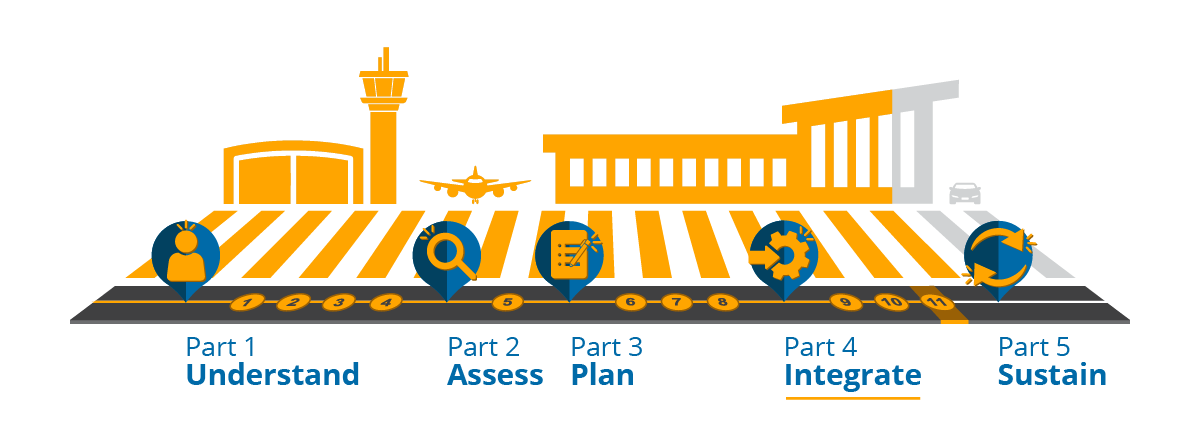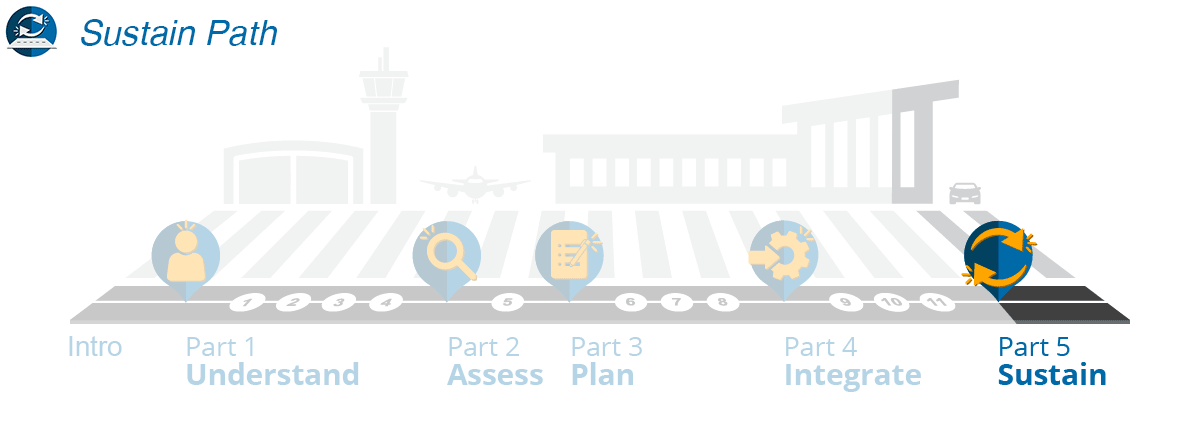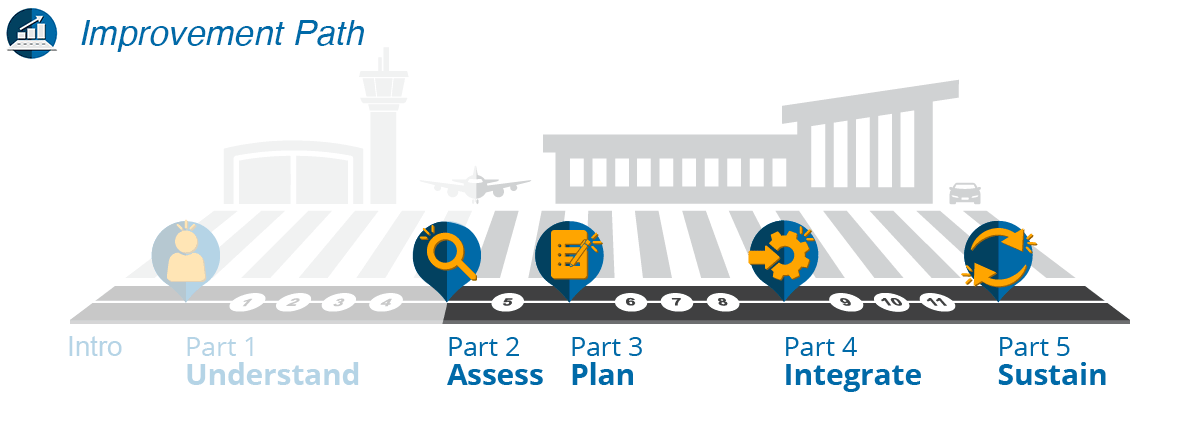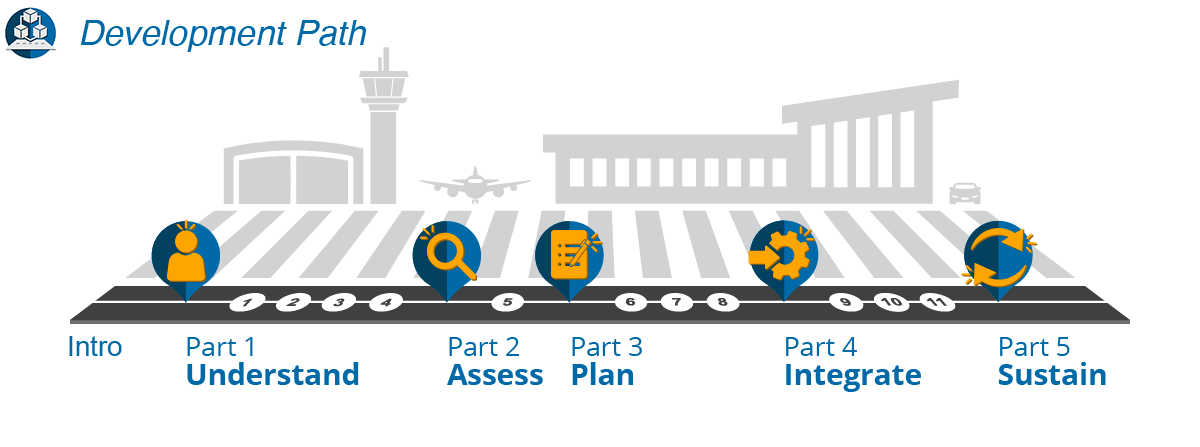
PATHS |  Development
Development  Improvement
Improvement
Step 11: Develop Procedures and Update Plans
Review and Update Existing Plans
This step is the last step toward implementing a program for integrating social media with emergency management (SMEM). In this step, we describe the process of updating existing plans or developing new plans and procedures necessary to support the SMEM program.
Crisis Communication and Airport Emergency Plans
At the foundation of the SMEM program are plans such as crisis communication plans (CCPs) and airport emergency plans (AEPs) along with any supplemental plans such as those for the joint information center (JIC), family center, evacuation, and continuity of operations. Since social media (SM) can impact operations, intelligence, and communications, be sure to review your entire plan and all procedures to ensure that elements of SM are properly incorporated into each section. These will include some of the core elements in your basic plan or airport annex, including the following:
- Direction and control
- Communications
- Life safety and property protection
- Community outreach
- Recovery
Within your CCP and AEP, the operation plans for your emergency operations center (EOC) and JIC will be most impacted by SM integration. Begin by conducting an overview of your plans and highlighting areas where SM integration will be included. As you edit the plans, keep your vision, goals, and objectives in mind and stay within the operating framework you identified in Step 10. We further suggest that you refer to the Resource tab to review sample plans and procedures from others and customize your own. You may also find value in connecting with other airports with similar characteristics to your airport who may have already completed efforts such as this.
Policies and Agreements
Incorporate policies and agreements identified and developed in Step 9 into your plans. Depending on the format of the plan, these may be within the plan itself or included as an external reference. Even though the references we provide may give you a great start on your policies and agreements, you should anticipate tailoring unique requirements based upon the regulatory and legal requirements that may apply. As you prepare or update your policies and agreements, make sure you review these changes with your legal counsel.
Develop/Update Response Procedures
Once you have updated your AEP and CCP, ensure your procedures are in alignment with your plan. If you already have some level of SM integration, review your existing procedures to address any changes that may be needed. Those just starting out with SMEM will need to develop new procedures and update others to incorporate each of the SM functions (listening, engaging, publishing, and reporting) you have chosen to integrate. These can be as detailed as necessary depending upon your level of integration. Incorporate checklists when possible to facilitate their use by those with SMEM duties and responsibilities.
Tips
For the Beginner
Collaborate with other airports or municipalities in your area to share plans and share templates since you will likely utilize many of the same response resources.
For the Advanced
Exercise your plan regularly, and, if possible, simulate SM content (on an offline or restricted site) to generate real-time responses.
Support Documents
Provide additional tools for your team for quick reference, such as the following list (if you already utilize such tools, assess them for SM integration):
- Call lists (EOC, JIC, operations)
- Contact list (include state, regional, and federal contacts)
- SM channel lists
- Message templates
- Checklists
- Account names and sites (ensure you have a process in place for lost or forgotten passwords)
Training Schedule
As part of your SMEM program, develop a training plan and schedule for SMEM. The integration will have little chance for success without training and practice. Include a review of the training schedule by any stakeholder or member with responsibilities in the plans to ensure they have the time and resources to participate. If you are just starting out, additional training time may first be needed to provide an understanding of SM and how it impacts emergency response and influences day-to-day operations. You should also provide room in your schedule for the whole community to understand the importance of what is being accomplished.
Coordinate with Outside Organizations
As with your other efforts to develop your SMEM program, keep the whole community advised on the plan progress, especially those in the airport community; as you update your plans and develop new procedures, their input is important. Provide an opportunity for them to give input on all sections where they have roles and responsibilities and validate their commitment to staffing their roles. Where necessary, ensure that copies of the procedures are incorporated into any agreements or memoranda of understanding (MOUs) you may have.
Review Plans and Conduct Training and Exercising
Distribute the first draft to group members for review, and revise the draft as needed. For a second review, conduct an orientation exercise with personnel who have a key responsibility. Revise the plan as necessary or conduct a tabletop exercise to work through the plan and obtain further feedback from the community. As you plan other drills and functional and full-scale exercises, include SM as a component.
Final Approval
After all reviews are accomplished, obtain written approval, and coordinate distribution of any updated plans and procedures. Ensure that all members of the community have a copy of your plan, procedures, and policies and maintain records of distribution.
Although this is the final step in developing your SMEM program, the work of sustaining the program is an ongoing effort. Part 5 is a resource for ongoing improvement and includes recommendations for the following:
- Improving community collaboration
- Adding on to what you have already built
- Going further by innovating and bringing new capabilities to your community team
- Learning more about SMEM integration




